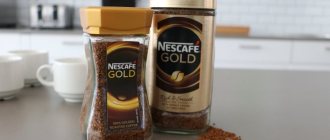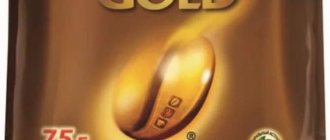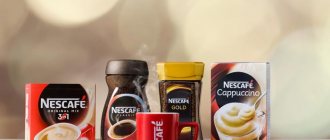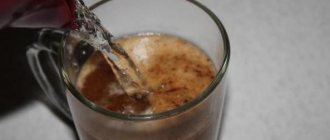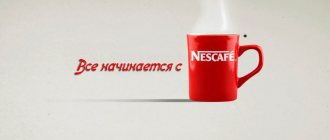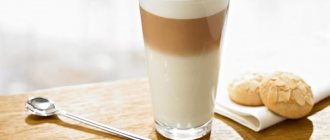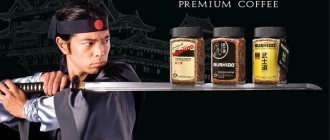Coffee is a favorite drink for morning energy. I drank coffee and got a burst of energy for several hours, you are happy, collected and concentrated. But popularly popular coffee bags, which are actually called “coffee drink”, are as different from real coffee as hawthorn tincture is different from elite wine.
Coffee bags are popular because of human laziness and greed. It costs a penny and is extremely easy to prepare - pour boiling water over it and stir, you don’t even need to add sugar, all inclusive. But what is the price of this simplicity?
We went to Auchan and bought three cheap bags of coffee drink (price less than 10 rubles) and, for comparison, one more expensive drink (price 30 rubles). Let's look at their composition and figure out what they offer us under the guise of “coffee.”
Attention! Everything described below is obtained based on information from open sources and our own taste sensations.
Participants
Participating in the inspection are:
- Nescafe "Classic 3 in 1"
- Jacobs "Classic 3 in 1"
- Petrovskaya Sloboda “Classic 3 in 1”
- Nescafe Gold Cappucino Chocolate
“3 in 1” in the name means coffee + sugar + cream. This is precisely the main advantage of the drink, because you just need to pour it into a cup and fill it with water. You don’t need to add anything, and the drink itself turns out quite tasty, which is very convenient if you need to take coffee with you to work, on the train, etc.
Let's take a look at the composition. You may assume that coffee should be the main ingredient of the drink, but if you take a closer look at the composition, you will be very surprised!!! Let's look at the composition using the example of classic Nescafe.
How many calories are in different brands of coffee?
The difference in the number of calories between different brands and brands is insignificant, but it still exists.
Despite the fact that production technologies differ little from different manufacturers, each brand uses different raw materials and additives, hence the difference in calorie content, although insignificant:
| Brand | Calorie content per 100 g | Calories per 2 teaspoons (10 g) |
| Carte Noire | 100 kcal | 10 kcal |
| Egoiste Noire | 92 kcal | 9.2 kcal |
| Jacobs Millicano | 116 cal | 11.6 kcal |
| Jardin Colombia Medellin | 92 kcal | 9.2 kcal |
| Moscow coffee shop on shares | 90 kcal The line includes drinks with a calorie content of 139 kcal | 9 kcal13.9 kcal |
| Moccona | 109 kcal | 10.9 kcal |
| Jacobs Monarch | 103 kcal | 10.3 kcal |
| Jockey | 130 kcal | 13 kcal |
| Tchibo Exclusive | 76 kcal | 7.6 kcal |
| Nescafe Classic | 45 kcal | 4.5 kcal |
| Black card | 71 kcal | 7.1 kcal |
| Ambassador | 119 kcal | 11.9 kcal |
| Milagro | 167 kcal | 16.7 kcal |
- How many calories are in coffee - calculating the calorie content of different types of drink
Nescafe "Classic 3 in 1"
Compound:
1. Sugar;
2. Cream substitute (glucose syrup, palm kernel oil, stabilizers E340(ii), E331 (iii), E452(i), E471, E472e), sodium milk caseinate, anti-caking agent E551, salt, flavorings, acidity regulator E451(i) ;
3. Natural instant coffee (c) Nescafe 8.8%;
4. Caramelized burnt sugar;
5. Salt;
6. Sweetener (sodium cyclamate);
7. Flavor
1 sachet contains 0.24 g of protein, 2 g of fat and 12 g of carbohydrates. Energy value: 68 kcal
As in the joke: these are not dumplings with mayonnaise, but mayonnaise with dumplings. So it is here: we have a whole range of sweeteners and chemical additives with a small addition of coffee.
One teaspoon of refined sugar contains 4.2 g of carbohydrates. It turns out that our drink contains almost 3 tablespoons of sugar. Not a bad start.
The creamer consists of glucose syrup, palm oil, sodium caseinate and various additives. For each additive with the “E” index, we will indicate the level of danger and origin (natural, artificial or synthetic), you can read more about this on the Additives.net website.
- Glucose syrup
is a harmful and cheap alternative to sugar. Glucose syrup does not cause an insulin response, as sugar does, and does not give a feeling of fullness. A striking example of a completely “empty” calorie content. You want to eat more and more sweets with glucose syrup. - Palm kernel oil
(obtained from the kernels of oil palm fruits) is a completely normal ingredient, a source of healthy fats and one of the few components of coffee that does not raise questions. - Sodium caseinate
is a milk protein and also does not raise any questions. - Salt.
There is no need for explanation here. - E340(ii) – potassium orthophosphate.
An artificial stabilizer, considered non-hazardous. - E331(iii) – sodium citrate.
A synthetic stabilizer, similar to salt, used to control acidity. Considered non-hazardous. - E451(i) – sodium triphosphate.
Synthetic powder, an acidity regulator, is harmless in small doses, but in overdose it can lead to calcium deposition in the kidneys, as well as the development of osteoporosis. Danger level: medium. - E452(i) – sodium polyphosphate.
An artificial stabilizer, used both in the food industry and in the chemical industry for the production of soap and washing powder. Danger level: low. - E471 – glycerol monostearate.
Artificial fatty acids, similar in structure to natural fats. Used in the production of mayonnaise, margarine and other fatty products. Danger level: low. - E472e – esters of glycerol, diacetyltartaric and fatty acids.
An artificial substance that imparts homogeneity, plasticity and viscosity, is widely used in the production of bread, cookies and candies. Considered non-hazardous. - E551 – silicon dioxide.
An artificial substance used to prevent caking and clumping of a product (emulsifier). Used in a wide variety of industries - from rubber and concrete production to optical fiber. Considered non-hazardous.
The manufacturer does not say what flavorings are used in the drink - this is allowed.
Caramelized burnt sugar is the same sugar. Salt is salt.
And finally, the last, rather controversial ingredient is the sweetener sodium cyclamate, E952. This is a synthetic sweetener, 30-50 times sweeter than sugar. Permitted in Russia, but since the 60s of the last century it has been banned in the USA as a possible carcinogen (data were obtained during experiments on mice). Now most experts believe that E952 does not directly increase the risk of cancer, but enhances the effect of other carcinogens. Danger level: high.
Oh yes, while listing all the ingredients, we forgot about coffee. Sorry. There really is coffee in the coffee drink.
